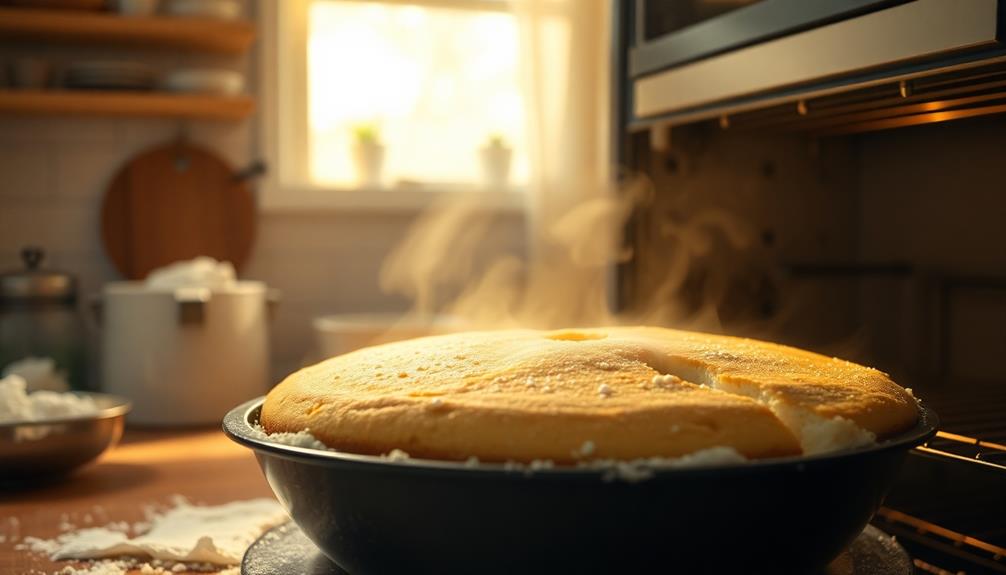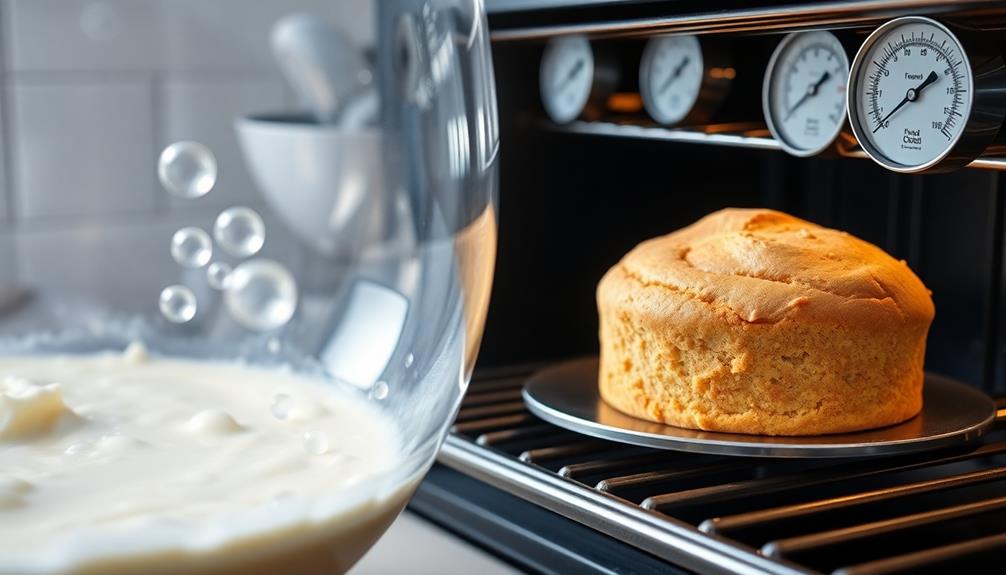Atmospheric pressure can surprisingly affect your baking outcomes. At lower pressures, gas bubbles expand faster, creating a coarser texture in your baked goods. This means you might need to adjust leavening agents to avoid collapse. Additionally, low pressure leads to quicker moisture loss, which can leave your treats dry. You'll also notice changes in cooking times because the boiling point of water is altered. High altitude brings its own set of challenges, requiring specific recipe tweaks. Understanding these factors can help you achieve perfect results every time. Discovering how to adjust will enhance your baking experience!
Key Takeaways
- Low atmospheric pressure causes gas bubbles in dough to expand rapidly, resulting in larger pockets and a coarser texture in baked goods.
- Baking at high altitudes requires adjustments to leavening agents to prevent cakes from collapsing due to rapid rising.
- Quick evaporation of moisture in low-pressure areas can lead to dry baked goods, necessitating extra liquid in recipes.
- The boiling point of water decreases with lower pressure, affecting cooking times and potentially altering the final product's quality.
- High humidity can clump dry ingredients, while low humidity can cause dry, crumbly dough, requiring careful moisture balance adjustments.
Effects of Atmospheric Pressure

Atmospheric pressure plays an essential role in how your baked goods turn out, especially when it's lower than normal. When you're baking at high altitude or during low-pressure conditions, your dough can rise more easily. This happens because the gas bubbles in the dough expand faster, leading to larger pockets and a coarser texture in your final product.
For instance, just as the rich flavor of Red-Braised Pork Belly is influenced by careful cooking methods, your leavening agents require careful adjustments to achieve the best results. While it might sound great to have extra rise, you need to be careful with your leavening agents. If you don't adjust them properly, your baked goods could rise excessively and then collapse.
Additionally, low-pressure areas, often caused by cold fronts, can lead to quicker evaporation and moisture loss in your dough. This shift can impact the texture of your baked goods, making them drier and less appealing.
Understanding how atmospheric pressure affects your baking allows you to make the necessary adjustments to your recipes. You'll find that with the right tweaks, you can achieve the desired rise and texture consistently, regardless of whether you're baking at sea level or up in the mountains.
Humidity's Impact on Baking

Humidity often plays a significant role in how your baked goods turn out. When the humidity levels rise, flour and sugar can clump together, complicating the mixing process. You'll want to keep an eye on your surroundings because ideal humidity for baking is between 40-60%. However, dough fermentation thrives in at least 75% humidity.
In humid conditions, you might need to reduce the liquid in your recipes by 10-25%. This helps counteract the moisture absorption by your dry ingredients like flour. Remember, warmer, humid air accelerates yeast activity, causing your dough to rise faster than expected.
Here's a quick look at how varying humidity levels can affect your baking:
| Humidity Level | Effect on Dough | Recommended Action |
|---|---|---|
| Low (below 40%) | Dry, crumbly dough | Increase water in the recipe |
| Ideal (40-60%) | Balanced texture | Follow standard recipes |
| High (60-75%) | Sticky, wet dough | Decrease liquid by 10-25% |
| Very High (75%+) | Quick rise, overproofed | Adjust timing & liquid |
| Extreme (>80%) | Clumpy ingredients | Use fresh, dry ingredients |
Navigating humidity can be tricky, but with practice, you'll master it!
High Altitude Baking Challenges

Baking at high altitudes presents unique challenges that require you to make specific recipe modifications. You might notice common issues like coarse textures or dry cakes if you don't adjust your ingredients and measurements.
For instance, using fresher ingredients, such as seasonal produce, can enhance your baked goods, just like how Nettle and Potato Soup benefits from fresh nettles.
Understanding these adjustments is key to achieving successful results in your high-altitude baking endeavors.
Recipe Modifications Needed
When you're tackling high-altitude baking, you'll need to make some essential recipe adjustments to achieve the best results. The lower atmospheric pressure can greatly affect how your baked goods rise and retain moisture, so here's what you should change: One classic example of how adjustments can enhance texture is in a Loaded Baked Potato, where the right balance of ingredients is vital for the perfect outcome.
- Reduce Sugar: Cut down sugar by 1-3 tablespoons per cup to prevent surface mottling and guarantee proper structure.
- Decrease Fat: Lower fat content by 1-2 tablespoons per cup to reinforce the structure of your baked goods.
- Add an Extra Egg: Incorporate an extra egg or egg white to boost liquid and protein, enhancing stability in your recipes.
- Adjust Baking Powder: Decrease your baking powder or soda by 1/8 to 1/2 teaspoon per teaspoon to account for increased gas expansion.
Additionally, don't forget to add 1-2 tablespoons of extra liquid per cup to compensate for moisture loss due to faster evaporation at high altitudes.
These modifications will help guarantee your baked treats rise beautifully and maintain their delicious texture, even when you're baking up high!
Common Baking Issues
High-altitude baking presents unique challenges that can frustrate even the most experienced bakers. The lower air pressure allows cakes to rise quickly, but this can overstretch cell walls, leading to collapse. Additionally, excessive moisture loss during baking can leave your goods dry and crumbly. To tackle these issues, you'll need to make some adjustments.
| Issue | Solution |
|---|---|
| Cakes may collapse | Reduce baking powder/soda by 1/8 to 1/2 teaspoon per teaspoon. |
| Baked goods can be dry | Add extra liquid to your recipes to compensate for moisture loss. |
| Mottled surfaces on cakes | Lower sugar by 1-3 tablespoons per cup. |
You might also need to increase baking temperatures by 25°F (15°C) to set your baked goods faster and improve their texture. By understanding these common high-altitude baking issues, you can adjust your recipes for better results and enjoy delicious treats without the worry of failure. Remember, a little modification goes a long way in achieving the perfect bake at high elevations!
Adjusting Recipes for Elevation

Adjusting recipes for elevation can make all the difference in achieving the perfect bake. When you're at a higher altitude, air pressure has two significant effects on your ingredients. First, water boils at lower temperatures, which can lead to quicker evaporation. This means you'll need to tweak your recipes to guarantee they rise and bake correctly.
Here are some essential adjustments to take into account:
- Reduce Sugar: Cut back by 1-3 tablespoons per cup to avoid moisture issues and mottled surfaces.
- Decrease Fat: Lower the fat by 1-2 tablespoons per cup to help strengthen the structure of your baked goods.
- Add an Extra Egg or Egg White: This provides additional liquid and protein, vital for maintaining moisture and structure.
- Adjust Leavening Agents: Decrease baking powder or soda by 1/8 to 1/2 teaspoon per teaspoon to prevent over-rising and collapsing.
Managing Temperature Variations

Temperature control is essential for achieving consistent baking results. When you encounter temperature variations, you need to adjust your methods to guarantee your baked goods turn out perfectly.
Warm, humid conditions can enhance yeast activity, leading to quicker dough rises. To optimize this, monitor proofing temperatures between 95-110°F with 80-85% humidity.
In high-altitude conditions, pressure has two main effects: it can cause boiling points to lower and require you to increase baking temperatures by 25°F (15°C). This helps your baked goods set properly and prevents excessive moisture loss.
Fluctuations in oven temperature can lead to uneven baking. Maintaining consistent oven temperatures is critical for reliable performance.
Understanding how temperature affects the boiling point of water is essential, as water evaporates faster at higher altitudes, potentially impacting the final texture of your treats.
Chemical Leavening and Structure

When baking, understanding how chemical leavening affects structure is essential for achieving the right texture in your treats. The interaction between atmospheric pressure and leavening agents can greatly influence your results.
At higher altitudes, where pressure inside the oven is lower, gas bubbles form larger pockets, leading to a coarse texture that might collapse.
Here are four key points to keep in mind:
- Excess leavening agents: Using too much can cause quick breads to collapse, as rapid gas expansion overwhelms the gluten's structural support.
- Timing matters: Activate leaveners only when your dough or batter is ready; otherwise, it may fail to hold its shape.
- Pressure effects: Lower atmospheric pressure allows baked goods to rise more quickly, which can create fragile textures.
- Temperature considerations: Leavening agents can react differently because they boil at lower temperatures in low-pressure environments, affecting the final product.
Innovations in Baking Technology

Baking technology has come a long way, transforming the way you create and perfect your favorite recipes. With innovations like pressure-controlled ovens, you can now adjust the atmospheric pressure during baking, which is especially helpful when the pressure is lower at high altitudes. This technology guarantees consistent results, making it easier to achieve that perfect rise.
Additionally, automated humidity sensors are revolutionizing how you manage moisture levels in your ingredients. These sensors allow you to adjust liquid ratios in real-time, countering the effects of humidity on absorption.
Here's a quick look at some innovations in baking technology:
| Innovation | Benefit |
|---|---|
| Pressure-controlled ovens | Consistent results at varying altitudes |
| Humidity sensors | Real-time adjustments for liquid ratios |
| Smart ovens | Precise control over temperature and pressure |
Moreover, advances in packaging for dry ingredients minimize moisture absorption, enhancing the performance of staples like flour and sugar in humid conditions. Research into leavening agents has also led to formulations that withstand pressure variations, reducing the risk of collapsed baked goods. Embrace these innovations to elevate your baking game!
Practical Tips for Bakers

When you're baking, adjusting your liquid ratios can make a big difference, especially in high humidity.
Keep an eye on the weather conditions, as they can affect your dough's fermentation and rising times.
Adjusting Liquid Ratios
Adjusting liquid ratios is essential for achieving the perfect texture in your baked goods, especially when environmental conditions change. When humidity levels rise, you need to be proactive. The weight of air can affect how your ingredients behave, and liquids evaporate more quickly in high-altitude conditions.
Here are some practical tips to help you adjust your liquid ratios effectively:
- High Humidity: Reduce liquid by 10-25%. For example, consider cutting down about 1/4 cup per recipe to prevent overly sticky dough.
- High Altitude: Add 1-2 tablespoons of extra liquid per cup. This helps counteract moisture loss due to lower atmospheric pressure.
- Chemical Leaveners: Adjust liquid carefully to maintain structure. Too much moisture can lead to collapsing quick breads.
- Indoor Humidity Monitoring: Keep an eye on humidity levels in your kitchen. This awareness will guide your adjustments, leading to better texture and consistency in your baked goods.
Monitoring Environmental Conditions
Monitoring environmental conditions is essential for achieving consistent baking results. Pay close attention to humidity levels in your kitchen; high humidity can cause flour to absorb excess moisture, resulting in sticky dough and affecting the crust texture.
To manage this, consider using a hygrometer to measure indoor humidity. When humidity is high, you might need to reduce your liquid by 10-25% to maintain the right consistency.
Also, keep an eye on local weather forecasts to track atmospheric pressure changes. These fluctuations can greatly impact your baked goods' rise, especially during cold fronts.
Consistent temperatures in your baking space are vital, as temperature shifts can alter ingredient interactions and baking times.
If you often deal with humid conditions, investing in a dehumidifier can create a more suitable environment for baking, helping to prevent dough issues.
By monitoring both humidity and atmospheric pressure, you'll be better equipped to tweak your recipes and achieve the perfect bake every time.
Implementing these practical tips will set you on the path to baking success!
Exploring Baking Science

Baking science is a fascinating interplay of chemistry and physics, where even slight variations in atmospheric pressure can greatly impact your results.
Understanding these principles helps you achieve the perfect bake, especially when it comes to managing air and moisture in your recipes.
Here are four key ways atmospheric pressure affects your baking:
- Gas Expansion: Lower pressure lets gases expand more easily, resulting in higher rising baked goods, akin to high-altitude baking.
- Moisture Management: During low-pressure conditions, like a cold front, moisture loss accelerates, which may lead to drier outcomes and affect texture.
- Boiling Point Changes: The boiling point of water decreases at lower pressure, altering cooking times and moisture content, so adjustments are essential for ideal results.
- Leavening Adjustments: In low pressure, excess leavening agents can cause quick breads and cakes to collapse due to rapid gas expansion.
Frequently Asked Questions
How Does Air Pressure Affect Baking?
Air pressure impacts baking by altering how your ingredients interact. Lower pressure lets baked goods rise more easily, while higher pressure can make them denser. Adjust your recipes according to the pressure for better results.
Does Atmospheric Pressure Affect Cooking?
At high altitudes, water boils at about 198°F instead of 212°F, affecting cooking. Yes, atmospheric pressure impacts cooking; you'll need to adjust times and methods to guarantee your dishes turn out perfectly every time.
Does Barometric Pressure Affect Baking Cookies?
Yes, barometric pressure affects baking cookies. Lower pressure can make them spread more and be chewier, while higher pressure can lead to denser cookies. Adjust your ingredients and baking times for best results.
Why Do Baking Instructions Differ Based on Atmospheric Pressure?
Baking instructions differ based on atmospheric pressure because it affects gas expansion, moisture levels, and cooking times. You need to adjust your ingredients accordingly to achieve the perfect texture and rise, especially at different altitudes.
Conclusion
As you step into the kitchen, remember that every rise and fall of atmospheric pressure can surprise you in your baking journey. With the right adjustments and a keen understanding of how humidity, altitude, and temperature play their roles, you'll reveal the secrets to achieving perfect pastries and breads. But what happens when you push the boundaries of these elements? The next time you bake, keep an eye on the skies—you might just discover something extraordinary.










